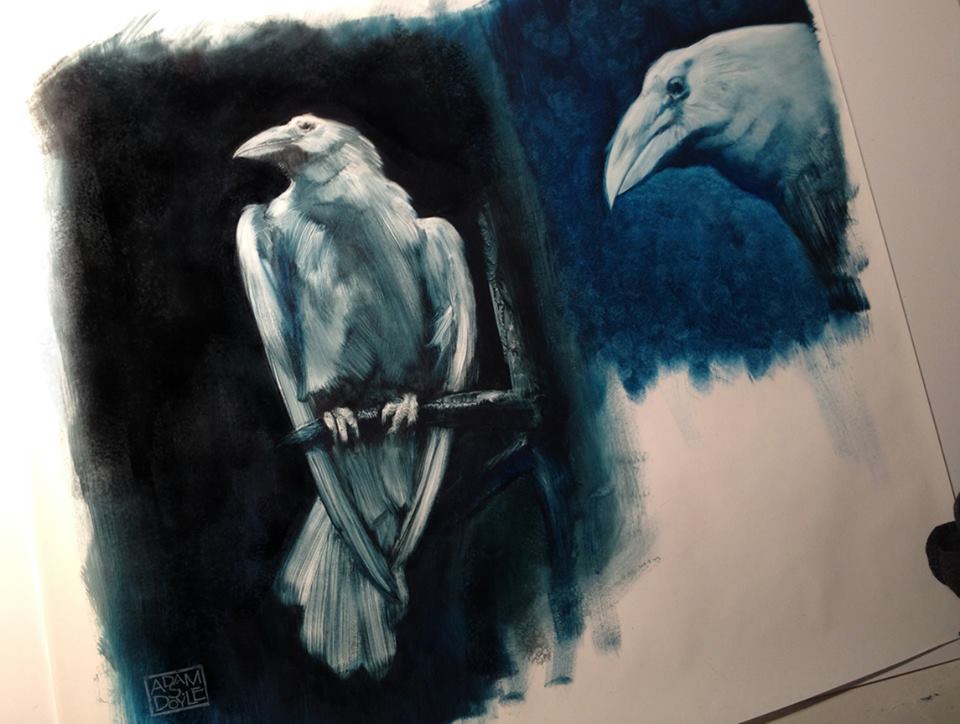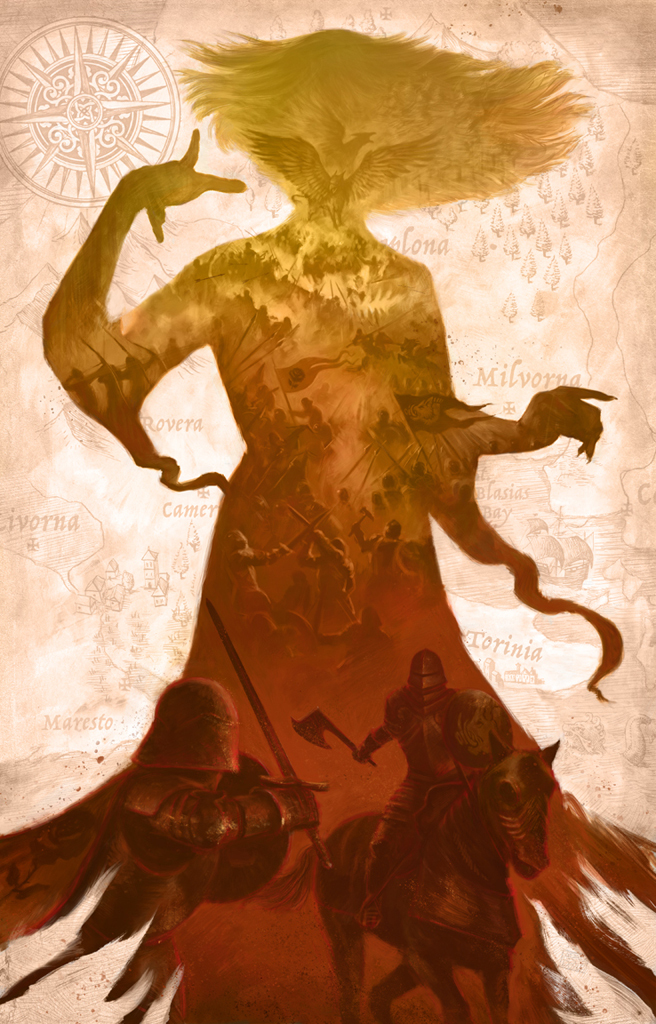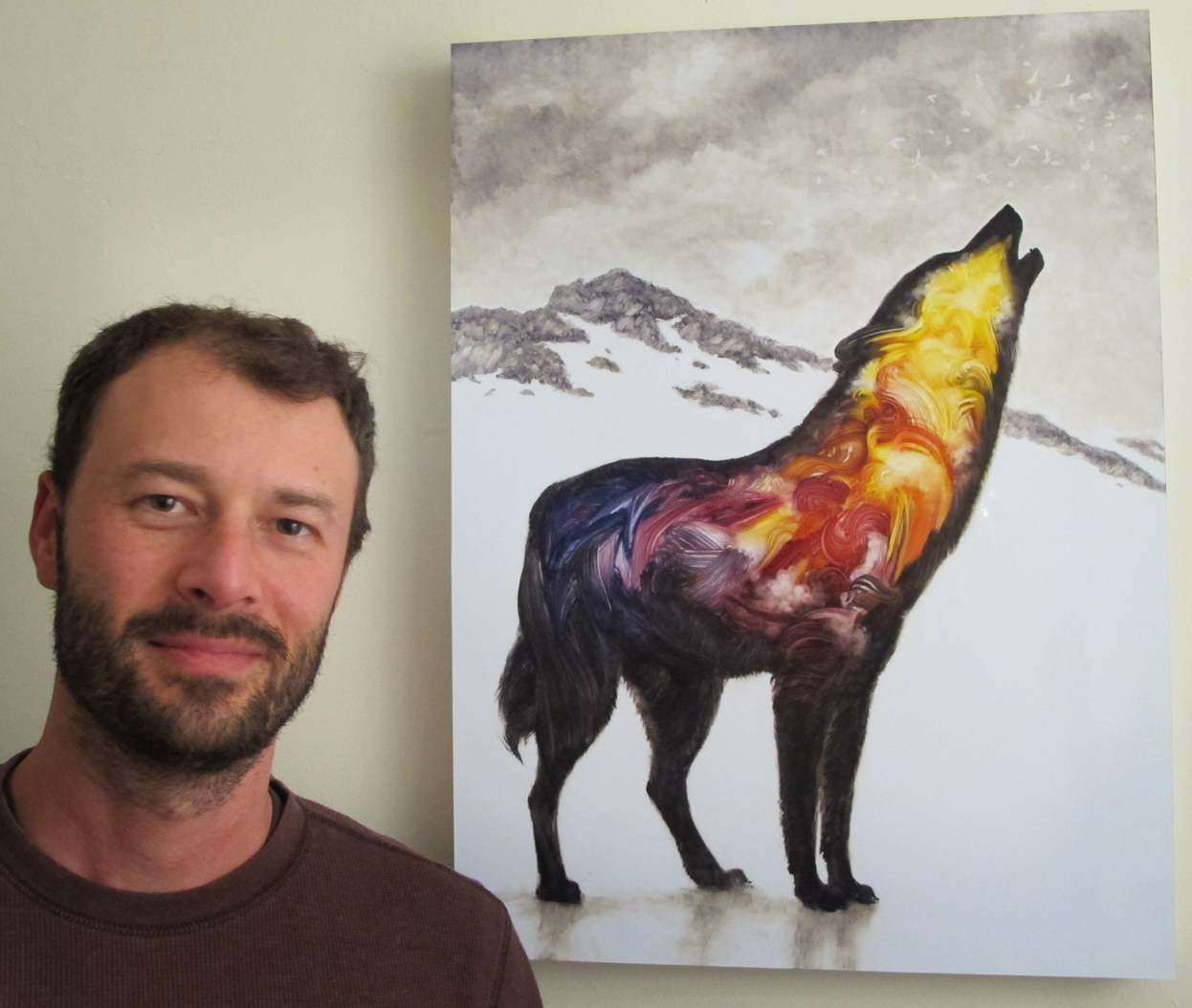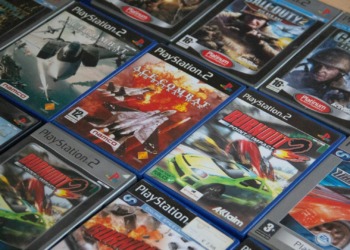Adam S. Doyle is an illustrator and designer based in New York. In this article, Adam shares his story, discusses the importance of color in the storytelling, gives pieces of advice for those artists who feel frustrated in front of the freshly-white canvas and much more.
Imagine yourself in the comfortable armchair near the fireplace with a cup of hot chocolate and you plunge slowly into the beautiful art world of Adam S. Doyle.
https://www.youtube.com/watch?v=hSJu82aLArc&feature=youtu.be
Adam, tell us how and when did you discover your passion for art? What is your story?
I don’t remember being born, nor do I remember when art became a part of my life. I drew like most kids do. I kept at it because it was an imaginative experience and people around me were encouraging. I’d draw for the girls I liked. I did murals on the walls of my bedroom. I did the posters for shows in high school. The big turning point came when I had to decide where I wanted to go to college; whether to pursue art fully or be sensible and let it just be a hobby. My family and friends have always been supportive. I opted to go for it.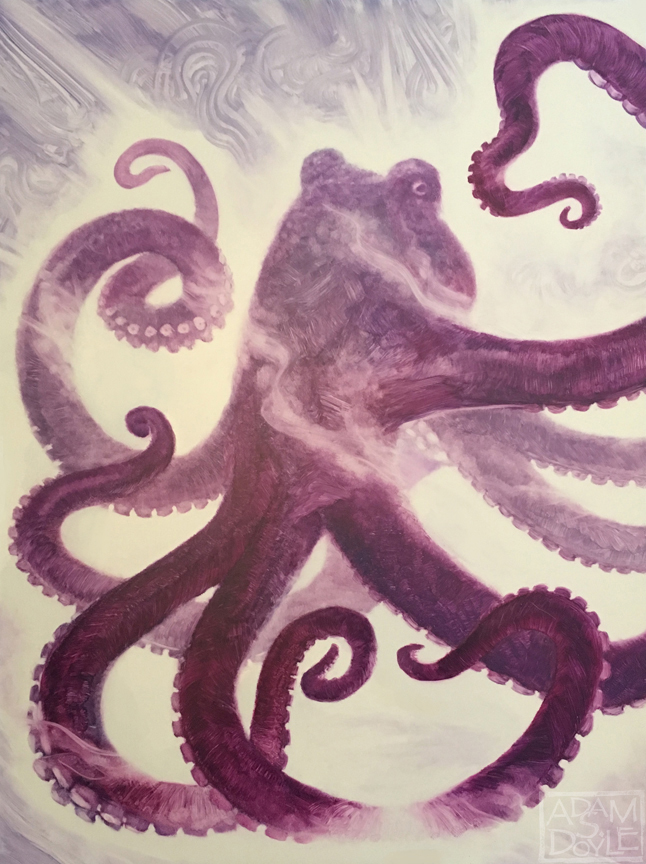
- Photo Credit: Adam S. Doyle
How did you come to the style you have right now?
Hard work. As previously mentioned, I’ve been creating images since childhood. Nothing happened overnight. When I was starting out professionally I was into the raw, sketchy lines of the pencil. Everything came out of my sketchbooks. I wanted to keep that lively looseness. Later it was the wet splatters of ink. When I was in grad school I turned to rough strokes of paint. I’ve always been excited by being able to depict things with very visible marks. They each share the quality of transforming the blank surface into a lifelike figure or a believable space; that’s a kind of magic.
Each stage of my work has been about exploring different paths that have ultimately come to be what you see today. These paths include a fascination with the magic of making the paint come alive, a love for the natural world, psychology, technology, as well as a compulsion to depict energy, which arose in no small part due to growing up with a father who’s a lifelong acupuncturist. I’ve orchestrated these interests into bold, dynamic compositions.
Having a distinctive look is an asset for getting known, but it’s also important to not get trapped by it. Style over substance won’t last long. I’m not interested in doing the same thing over and over again. As I live and learn my work is also evolving.
You have a wonderful combination of colors. Does color have a meaning in your paintings? How important is color for telling the story in your paintings?
That’s nice of you to say. I have a healthy respect for color. It can easily overpower an image if you’re not careful. Yes, color is important to me. It has its own vocabulary and associations, depending on the context.
For example, red is powerful to our eyes, partly due to our ingrained association with blood. It’ll pop off the page. A touch of yellow can help a painting look like it came from a couple hundred years ago. I do have a thing for blues, which have a cooler temperature and vibe well with portraying what the future may look like.
I primarily allow the color to be an emotional conduit. I’ll also use it as a compositional tool, moving the viewer’s eye from a key detail through the rest of the piece. I like the personality of colors and try to arrange them together in ways that make for a subdued moment or a loud, raucous party. Mostly I keep my palette simple, with one main color and a secondary as an accent. As a punctuation.
Because my paintings are usually not set in the real world, color is a lens to see things as if from another dimension. Monochrome allows me to portray the outside and the inside of the bird without any logical interruption. In my world colors accentuate the dream vision of my narratives.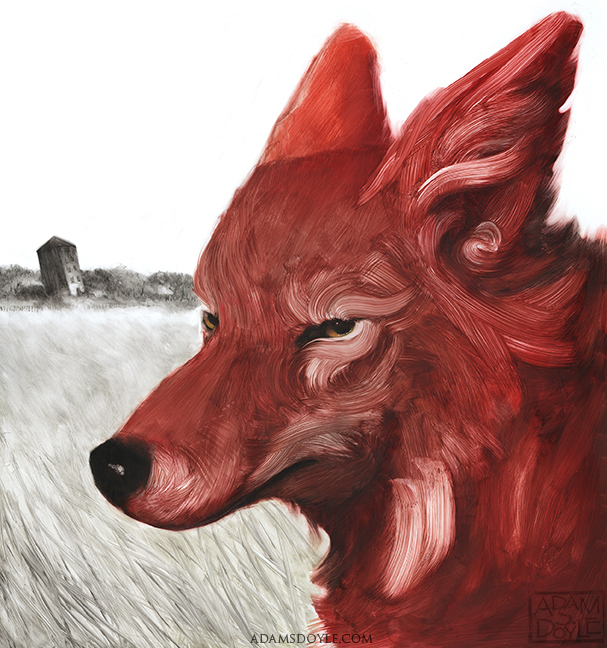
Photo Credit: Adam S.Doyle
Let’s talk about your series “Sky Born – Totems of Achievement”? Where did the inspiration come from? Why did you choose Ravens for your painting series?
That was one of the first bird series I did, upon the request of a gallery owner in Chelsea, Manhattan’s prominent gallery district. They’ve since been a popular subject they’ve shown in other galleries and cities. Frequently folks get them tattooed as well.
To answer your question succinctly, I like how birds are both messengers of nature and symbols for our aspirations. They’re lovely animals. I had a parakeet when I was living in Hong Kong. They’re globally familiar to all cultures. They live with us in our cities, connecting us in a sense to the wild landscape just outside the borders of our buildings. Birdsong is deeply entwined with our brains. We’ve evolved to trust their sound. When they’re quiet, it signals that threat is near. When they sing, we unconsciously know that all is well in our neck of the woods.
They’re also powerfully symbolic. The flight itself is the very personification we have for our hopes, dreams, and personal aspirations. Birds embody the limitless pursuit of freedom. Those aspects were in my mind when I painted that series.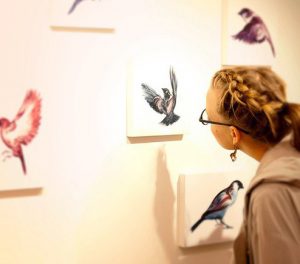
Photo Credit: Adam S. Doyle
What message are you sending to the world through your paintings?
The stroke of paint says “I am human and I exist.” That’s honoring our legacy since the men and women, our earliest ancestors, painted on cave walls 40,000 years ago. Those paintings are still there.
Every generation since then has developed and refined our place in the world, our relationship to each other, and our experience of being alive, through the elaborate or very basic mark of paint.
Furthermore, the stroke of paint on the white surface literally transforms nothing into something. That same stroke takes the white canvas anyone can buy, into a living, breathing, falling, flying, preying, praying, or playing figure. That’s magic. We look into the distant mountain peak of a landscape that doesn’t actually exist.
That’s magic.
We’re so accustomed to paintings that this is all easy to forget. The overabundance of information has desensitized us. One of my motivators is giving people a moment to take a breath. I’m not interested in assaulting your senses. There’s enough of that going on already. I hope people can have a lifelong relationship with my work.
I’ve lived through magnificent times and challenging times too. It’s all inside the painting. There’s purposefully room there for you to have your own interpretation. So that years down the road, you can connect with your own energy. If needed, it can be the reassurance that you’re not alone.
The painting is as much an embodiment of “I exist” as “we exist.”
I am curious, what is happening in your head, what is your mind about when you sit in front of the blank canvas and then start working on the painting? Some artists fear to start, and drawing seems for them almost impossible. How do you fight this fear (if you have it)?
The blank page can definitely be overwhelming. This is mostly due to its infinite potential. The possibility is there for the best thing you’ve ever done. So don’t screw up! I’m certainly familiar with how it can cause you to put off doing anything, lest another weak image comes out and has you feeling incompetent.
There are a few ways to get through this. The first idea is to draw and paint on cheap surfaces so that you stay loose and not getting too precious about making things perfect. Doodle. Draw from life. Keep the distance between you and the paint to a minimum.
The second trick is to let the idea well up inside of you like a volcano until you can’t hold it back from bursting forth. I do this a lot. The page can’t overpower you when you’re seeing past it with an unavoidable vision.
In my own routine, I come up with lots of ideas before squeezing color out of the tubes. For example, when I’m doing a book cover I’ll read the story and take notes. Once I’m half-way through I’ll start sketching. I sketch a lot. I may do upwards of fifty to over a hundred independent cover ideas. I’ll show the art director 3-5 of them.
The crux is that as much as we get caught up in the way things look, it’s really your ideas that are your greatest contribution.
Anyway, enjoy the research, getting familiar with the design of old seafaring ships, or the components of a spacesuit, or whatnot. This is like when an actor gets to know the character they’re portraying. This is where all the trying out of different directions happens, as well as getting to know the protagonists and antagonists, the themes of the story, and trying out unexpected compositions and colors. Things stay rough through this stage. I don’t want to get too detailed because I want to save that for the experience of painting.
I’ll sketch then let the idea develop in my mind while going for a run or a bike ride. When I can’t hold it in anymore I barely notice the blank page because I’m consumed with bringing the image to life. Even at this point, failures happen. All the time. Let the learning happen along the way. The unsuccessful ones will help you with the next piece. It’s all a process. Be patient with yourself. You haven’t seen all of my work, not a fraction of it. I only show my best stuff. That’s the way it goes.
In one of the articles I read, I stumbled upon the phrase that your “artistic mission is as an “ongoing investigation.” Can you tell us more about it? What have you investigated so far?
It’s a common misconception that artists have an idea for an image fully-formed and all it takes is putting brush to canvas to bring it into the world. The fact is that making art is an organic process of being alive, having experiences, learning from the discoveries made by countless pioneers who’ve come before, feeling the pulse of culture today, and any number of other influences.
The act of making images is in itself a learning and discovering process. The Impressionists didn’t appear out of nowhere with a cool new brushy look for the novelty of it. They were painters who responded defiantly to their times in the 19th century. They were rebelling against the establishment of the Salon in Paris, which was considered the only portal to get work seen by the public. And the Salon had defined perimeters for what they considered art. Manet, Monet, Cézanne, and others stepped out from the studio and captured their lives around them; not the requisite idealized historic events. Furthermore, and more to the point, in their practice they each had a dramatic effect on our perception of light, time, and space. Soon after, Einstein published his groundbreaking theories on these same fundamental subjects. (Read more about this connection in Leonard Shlain’s terrific book Art & Physics).
Artists operate from an intuitive place. Scientists are driven to prove. Everything we know as true is the result of those who committed their lives to trying to understand the way the world works. More to the point, in their practice, they each had a dramatic effect on our perception of light, time, and space.
The artists we know today did something not only to the world of art but what they did affected how we see and experience our reality. That may sound dramatic but it’s true. I’m not going to make any kind of claim on my own work. All I’m saying is that the need to explore is a significant motivator. The disciplines of art and science are fundamentally about our search for truth. Yes, their approaches are completely different. The former is about portraying ideas, stories, and meaning. The latter is tasked with proving how it all works. But I’d argue that at their core, both are about a search for truth and understanding.
Photo Credit: Adam S. Doyle
My focus is in creating images that open our eyes a little bit wider to the texture of reality. I’m trying to uncover inner landscapes. I’m contemplating what it means to be human today. As I mentioned, my investigation is an ongoing effort to reveal the nature of energy, the human mark, our connection to wildlife, and to respond to life as it happens.
My goal is to be responding to the state of all humanity through my own visual vocabulary.
Where do you usually find inspiration?
That addictive fuel for the creative engine. I could quote Chuck Close, who said “Inspiration is for amateurs – the rest of us just show up and get to work,” which is both dismissive and at the same time emboldening. But that’s really only an issue if you sit around waiting for it.
I’ll split inspiration into two categories. As I mentioned, when working on a project I find inspiration within the research and understanding of the task at hand. That’s direct inspiration. Let’s say I’m depicting a story about a girl who feels emotionally trapped. A visualization of that might be depicting an ‘unlocking.’ I’ll research locks and keys. In gathering photos and reading I’ll see how key teeth fit into and push the tumblers inside the locking mechanism. I’ll sketch old fashioned keys and be drawn to their flourished, brass handles. These visual elements become resources for how I depict the concept. This is direct and specific to the task at hand.
The other form of inspiration is indirect. All those things that fill me with energy and get me excited to paint.
I spoke about the big themes. Now I’ll just list off an eclectic mix: going for walk in the woods, the softness of clouds from 30,000 feet, underground caverns, the protests and marches against the current administration, biking through NYC blasting Sleigh Bells in my earbuds, Gorillaz, Hans Zimmer, the mountains of Iceland, the old neighborhoods of Rome, hitchhiking across New Zealand, the dolphins of Bali, Burning Man, the smell of waffles, the films of Christopher Nolan, Edgar Wright, the significance of Wonder Woman, the stories of HG Wells, Alan Moore, Harold & the Purple Crayon, Calvin & Hobbes, Sherlock Holmes, Joseph Campbell, Mary Shelley, Neil Postman, Oliver Sacks’ accounts of his patients, acts of kindness, enlightening podcasts, videos of unlikely animal friendships, the paintings of John Singer Sargent, Jenny Saville, Andrew Wyeth, the drawings of MC Escher, Heinrich Kley, Hokusai, and Duchamp for making a mess of what we consider art, catching a frisbee from a huck down the field, landing in a new country, Westworld, American Gods, Rick & Morty, Black Mirror, the Planet Earth series, self-driving cars, artificial intelligence, interplanetary travel, aliens, ghosts, cryptids, philotic connections, quantum entanglement, the kiss that confirms a woman is into me too, falling in love, a girlfriend wearing my sweatshirt, Netflix with a pile of pets, puzzles, riddles, trivia night, labyrinths, doppelgängers, and of course, octopuses.
A very eclectic mix! What is your philosophy regarding fine art?
Art is an exploration of meaning and understanding. It’s a frontier. It can get caught up in being turned into commodities for the highest bidder and a nice piece of decoration for that space above the couch. But art has an undeniable role in the experience of the human condition.
It is our way of contemplating what is and opening our eyes to what can be.
What are your plans? Your next shows?
I have work that will be going up in shows and bookstore shelves this fall and winter. Feel free to follow my social sites for updates. I want to say thanks for taking an interest in my work. Making a living as an artist is tough. Trying to do good work, find acceptance and making enough money to get by; it’s all endlessly challenging. But knowing that there are people out there who find value and meaning in what I do makes it all worth it. So thank you.


